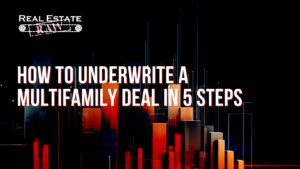The offering process can be quite different depending on the asset class we are discussing. In the single-family investing business, offers are usually made directly with a contract. The buyer or realtor will use a form contract and fill in the blanks with the buyer’s data.
Note-
This article is not specifically about using creative financing for multifamily properties, such as master lease options or seller financing for multifamily but you can certainly use this information to increase the chance of getting a multifamily creative financing offer accepted.
In commercial real estate, most offers are made with a letter of intent (LOI). The LOI is exactly what it sounds like. It’s a nonbinding letter that allows the buyer to state the general terms in which they would be willing to purchase the deal. The LOI will spell out the basics such as price, due diligence period (the look), earnest money, and the general time frame to close the deal.
The LOI allows the buyer and seller to negotiate the basic deal terms without spending the money to have an attorney draft a full contract. This can cost several thousand dollars in attorney fees at a minimum and could go way up from there.
Once the buyer and seller have agreed on general terms, you can take the LOI to an attorney and have them draft a full contract. That contract will be sent to the seller’s attorney (assuming you are the buyer), and the negotiation begins. I also strongly recommend that you resist the urge to find contracts online and use them without the aid of legal counsel. Always have an attorney draft and review all documents before executing them.
I have to share a misbelief that I recently had dispelled, which is that it’s cheaper to have your attorney review a new document than to review an existing one. Wrong! What I didn’t realize is that most attorneys have templates for the documents they use on a regular basis. To review an unknown document takes more time than to use one they are already familiar with.
Therefore, it will be cheaper and easier to have your attorney draft the first round of the purchase and sale agreement (PSA). When a buyer and seller agree on the LOI terms, one of the two sides needs to be the first to submit a first-round draft of the PSA. Make it your side (if possible). If the seller drafts first, you will likely spend more money having your attorney review it.
Here are the major points that should be included in an LOI:
- Price
- Terms
- This is typically cash as closing unless you are asking for the seller to carryback debt (a second mortgage).
- Keep in mind that cash as closing does not mean that you are buying the asset with all cash and no debt. It means that you are giving the full sale price to the seller at closing (with money from the lender).
- If the sale will be contingent on the seller issuing a second mortgage at closing, or if you are asking for creative financing, note it in this section of the LOI.
- Earnest money
- This is typically 1 to 3 percent of the purchase price.
- Earnest money is due to be placed in escrow (with the attorney or title company) within five days of the execution of the PSA (effective date).
- Inception period
- This will be your due diligence window or the look.
- For most commercial sales, this is thirty days.
- Time frames
- This is the total contract time frame with a closing date.
- This is typically a thirty-day look plus thirty days to close, for a total of sixty days to close from the effective date.
- Add an extension period. Additional days to close if need be.
- Be prepared to add extra earnest money to “purchase” the extension.
- Due diligence
- Provide a list of items that you will be requesting in your due diligence.
- See appendix A for a list of due diligence items.
Sometimes price is not what wins a bid for an asset. Surety of the close is the main concept to consider when crafting an offer. A seller will not be impressed with an offer of $1 million more than their asking price if they don’t think you can close.
Terms are the best way to create confidence in a seller. Terms include things like earnest money or a due diligence time frame. Sometimes you are faced with a deal in which you cannot put in $1 more than what you have already offered. Sometimes you and another buyer have offered the exact same purchase price. Now what? When trying to strengthen your offer without bringing in more money, tighten up on the terms instead. Here are a few suggestions:
- Increase earnest money.
- There is no limit to how much you can put up as earnest money. The more, the merrier.
- If you don’t close, you will lose this money, so be careful.
- You can also make the earnest money nonrefundable the day you execute the contract. This is attractive to a seller but is exponentially riskier for you.
- Shorten the due diligence period.
- The standard look is thirty days.
- You can shorten this to fourteen to twenty-one days.
- Make sure that you can get all your due diligence done in that time frame.
- Shorten the contract time frame.
- This is the riskiest of all the suggestions. This is easier to do if you are not applying for a loan to purchase the asset. If you are applying for a loan, they can take twenty-one to forty-five days to close on average. Your contract time frame must allow for the loan process, or you may be at risk of passing the contract close date.
- Attach your résumé to the offer.
- If you have an existing portfolio, you may want to attach your résumé with the LOI upon submission.
I love a good old-fashioned bargain but be careful not to damage relationships with low offers. If you are working directly with an owner, then I would be less concerned about this. If you are working with a realtor, don’t get the messenger killed.
A realtor has been hired by a seller to get them the best price possible. If you submit a low offer for an asset, you may make the realtor look bad to the seller. This realtor may remember that the next time you want to work with them in the market.
A realtor has a fiduciary duty to submit (to the seller) any offer that is presented to them in writing. If you submit a low offer, they are legally obligated to turn that over to the owner, but they have no obligation to recommend the offer. As a matter of fact, they are likely to do the exact opposite and suggest that the seller ignore the offer.
The key to submitting lower than expected offers is to get the realtor on board with the offer before you submit the LOI. If, after your analysis of the deal, you decide that your offer is considerably lower than the asking price, get permission from the agent to submit the offer.
When I realize that my offer to purchase is going to be more than 15 percent lower than the seller’s asking price, I will reach out to the agent and spend a few minutes explaining why my offer is low (usually because of low NOI or deferred maintenance). Then I ask, “Should I submit the offer or not?” The agent will usually tell me to submit it. Using this technique accomplishes several things. I get the realtor to buy in to my offer and take responsibility for bringing it to the seller, or the realtor tells me not to bother with the offer and thus saves themselves any embarrassment with the seller. Either way, I am valuing and retaining my relationship with this agent.
Being able to quickly make an offer on an asset is a skill that will serve you best when contacting owners directly through a direct contact campaign, such as texting or mailing potential sellers with whom you don’t have a relationship. When working with realtors, you will want to do the complete opposite and make slow and accurate offers.
When you send a message to an unknown seller, you are hoping they contact you and want to sell a property. Keep in mind that this owner may have already had other people try to connect with them, and they may be suspicious of you and any offer you make. There are a lot of scammers in the world, and people are right to be cautious when they receive unsolicited interest in buying real estate they own.
The key is to be able to make an offer the first time you speak to a possible seller. How? Know the value of the assets in your area. I suggest that you do a few things before reaching out to possible sellers.
- Know what you should be paying for properties in your area. If these are multifamily assets, you will want to know what properties are worth per door in your area. Break assets down by age. Know what things are worth per decade of construction. For example, you should know what you want to pay for buildings constructed in the 1960s, 1970s, 1980s, and so on. Assign a general value to all assets built in each decade.
- Next do some quick math. Know what a property is worth based on the rents (income approach). You can look up rents in the area or ask the seller once you are speaking with them. Quickly calculate the annual rent. To do this, take the average rent per unit and multiply it by the total number of units. Then multiply that number by twelve to get an estimated annual rent. Now subtract 10 percent for vacancy and then subtract the estimated expenses (see the “Five-Minute Pro Forma” section in chapter 7 for the rule of thumb on this). You now have an estimated NOI.
- With the estimated NOI in hand, you can quickly calculate the value of the building using the cap rate formula and entering in the applicable cap rate for the area, age, and asset class of the building.
You may have other ways of rapidly figuring the value of a property, but the point is to be able to quickly discuss a general offer price once you have a buyer on the line. This is easier to do if you are buying single-family homes and harder if you are buying a multiple-unit property. When buying multifamily and commercial real estate, the value is largely based on the income, and that information is found on the property’s financial statement.
Asking a seller for their financials early on is likely to be met with hesitancy. What if a stranger called you up and asked you to send them all your financial information on your investments? Being able to make a quick offer allows you to determine whether you have a serious seller and whether they are willing to sell at a reasonable price. If you can give them a quick estimate of the value of their property, and they tell you that they want a lot more, then you are probably wasting your time. Move on.
The Purchase and Sale Agreement (PSA)
Once you and the seller have completed your negotiations and you have executed the LOI, you will move to the contract phase of the deal. I negotiate the deal; my attorney negotiates the contract. Even with sixteen years of experience in this industry, I am not qualified to negotiate a commercial real estate contract. That’s why I have a great attorney who does it for me. You should too.
Not just any law firm will do. Experience in commercial real estate closings (in that state) is critical. Get referrals from commercial realtors in the area. Knowledge of current market terms is what you are getting with a good local real estate attorney—counsel that is dialed in to the market will be able to negotiate the best terms for you. This is worth more than you are paying them. Your attorney will come to you with the final decisions on the contract items, but they will be the ones conducting the actual negotiations with the seller’s attorney. For most commercial deals, this process takes a few weeks. Use this time wisely.
The weeks between the LOI and the fully executed PSA are a great time to get a head start on funding and equity raising (if syndicating). This is when you should start reaching out to lenders or mortgage brokers to check out the lending appetite for the project. You will have this short window, plus the due diligence process, to get your loan qualified. By moving quickly on the lending process, you lessen the risk of losing the earnest money deposit. If you are raising private capital for the deal, get started just after your LOI is executed.
Everyone thinks their kid is cute, but there are some ugly people in this world. Somebody was wrong. Most sellers of real estate think that their deal is the best in the world. I’ve seen some ugly real estate deals in my career. Somebody was wrong.
Sometimes a seller is mistaken about the value of their asset. When this happens, it is up to you to educate the seller on the situation without totally pissing them off. You must be the one to tell them that they have an ugly baby (asset) without blowing up the negotiations.
To do this, use factual data and avoid opinions. You will want to point out to the seller the items that are in disrepair or even aspects of the property that may make it less valuable than some neighboring properties.
Use comparable properties and their amenities to show the value (or lack thereof) of the property at hand. Use comparable sales/rent per square footage from similar properties to show the seller that their property is overpriced.
If a seller’s asset has a low NOI, you can blame the lender for your low offer. If the seller has a low NOI, lending will be more expensive. The lender will likely lower LTV and raise your interest rate.
One of the best deals I ever did was a large apartment portfolio made up of three smaller complexes. It was several hundred units in total. It was listed on an extremely popular website that is known as the garbage can of deals. Thousands of people must have seen this deal for sale. No one saw what I saw, and I saw what no one else had.
The problem was that the property was only 67 percent occupied. This meant that the NOI on the T12 was low, and with an asking price of $4 million, it didn’t make much financial sense based strictly on the income approach. This was the mistake everyone was making. They were trying (logically) to price the asset based on the amount of revenue it produced. They needed to price the asset on how much money it could produce. This property had to be bought on pro forma.
First, I asked why the property was at only 67 percent occupancy to begin with. I started by assuming that all properties in the area were also around the same occupancy. I researched the other properties to see what the average occupancy was. I looked on the internet and called the other properties directly. What I found was that those assets were at about 95 to 97 percent occupancy in general.
Second, I drove to all the competitive apartment complexes within three miles of my asset. I spoke to the management of each property to see what their real occupancy was and at what rate they were able to grow their rents. I found my research to be accurate. Now I understood that the property shouldn’t be this poorly occupied, but it didn’t answer the question of why.
After a few conversations with the seller, I had my answer. He was an elderly gentleman who had owned the asset for about thirty years. He had paid off the mortgage twenty years ago and had no current debt on the place. He knew that his rents and his occupancy were low. He just didn’t care.
He did not have any loans on the property, and all the cash it produced was pure profit for him. He just didn’t feel like putting any more effort into it than he already was. I made a full-price offer that day. Less than two years later, I was able to sell the property for almost double what we paid for it. Not all deals are obvious at first.
This story illustrates a few key points from earlier chapters. I didn’t buy the property for cash flow, as there was none, but I knew there would be, and the equity in the deal would be worth more than cash flow. I also used all the cash flow that the property did produce to renovate the units that needed to be upgraded. This stopped me from getting any cash flow myself, but it allowed me to bring in fewer partners, and I needed less cash to get the deal done. Fewer partners means more equity for me.
I looked at a lot of deals to find this one. It was not luck or an overnight success. It was consistency. Remember the race to eighty. How many deals are you looking at each week?
I bought this property on pro forma. Not the realtor’s pro forma but my own business model that I vetted heavily during due diligence. It would be nice to say that we always buy our deals only on what the property is worth right now, but that is a narrow point of view that can cause you to miss some good deals. I will also add that buying something that is not performing financially is extremely risky and not for beginners.
I not only renovated the property but also found ways to increase the revenue by operating the property more efficiently than the seller. The value was not just in raising rents. If all you can do is raise rents to justify paying what a seller wants, you’re probably overpaying. Valuation through operation, not renovation.
For more information on making multifamily offers and the use of creative financing for multi family investing go to my website www.realestateraw.com.
Best of luck!
Bill Ham

































